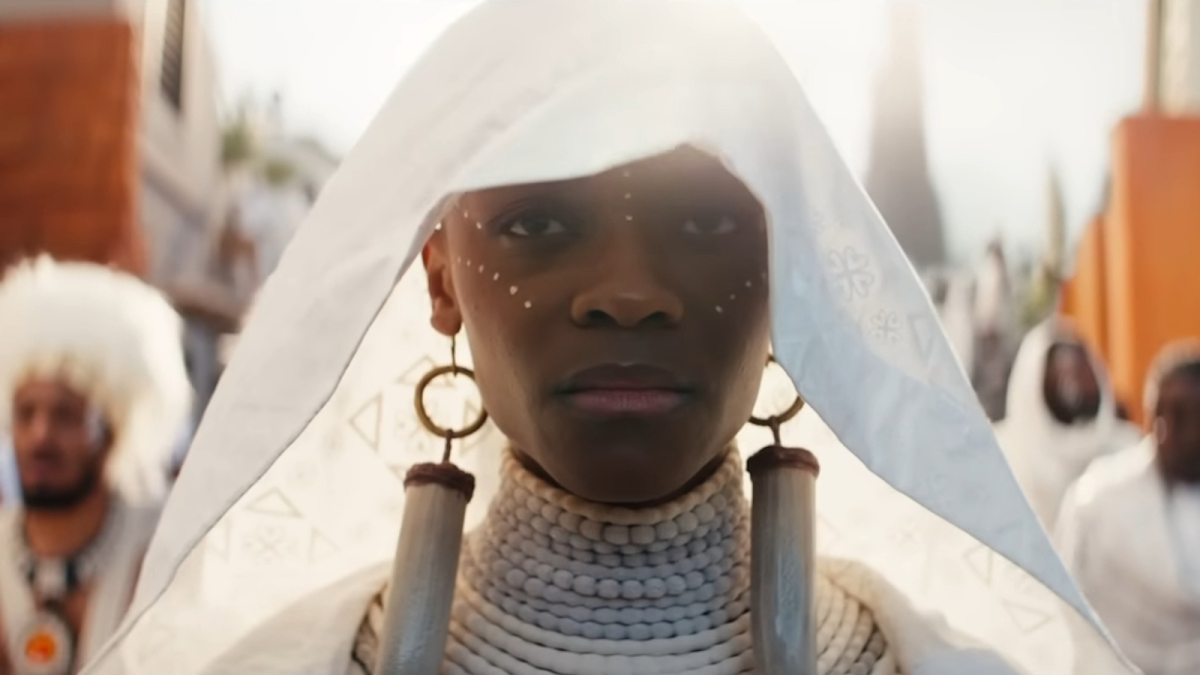The best moments in Black Panther: Wakanda Forever, come when the movie lets the characters and the audience grieve together. Through ceremony, dialogue, or even callbacks to earlier films, Wakanda Forever is as much a eulogy for the late Chadwick Boseman as it is another entry in the Marvel Cinematic Universe, for better and worse. It was inevitable that the film would have to address the awful, untimely death of Boseman, who had helmed the franchise as King T’Challa since the character’s introduction in 2018. Thankfully, Wakanda Forever handles this loss with grace and nuance, acknowledging the messiness of grief and anger that can come with death as monumental as this. At its best, it is a heart-wrenching and empathetic examination of grief mixed in with breathtaking action and spectacle. At its worst, it sometimes gets wrapped up in its own trappings.
Opening with the death and breathtaking funeral of King T’Challa, the movie wastes no time and never stops paying respect to Boseman. We never see a recreation of Boseman during these sequences (thank God). Instead, we see Angela Bassett and Letitia Wright as Queen Ramonda and Princess Shuri, respectively, show us their characters’ emotional truths in those moments, and so we are right there with them emotionally — a masterful and respectful choice on director Ryan Coogler’s part. After this loss, Ramonda and Shuri are left to face a world that wants to exploit Wakanda for its access to vibranium, as well as deal with the sorrow of losing a loved one. A year passes, and we find Ramonda and Shuri on very different paths in their journey with grief. Ramonda wants to help Shuri move through her grief, and decides to take her out into the bush to burn funeral garments, signifying the end of the grieving period for them both. Shuri refuses, too angry to let go. It’s here we meet Namor (Tenoch Huerta, wonderfully broody), the leader of the underwater nation of Talokan, who also happens to have vibranium as well. He wants to protect his people from the exploitation of the outside world, much like the Wakandans, but Namor isn’t afraid to bloody his hands to do so. This is one of the many places where the movie’s central tension (similar to the first film’s) shows up — should you burn the world down to protect yourself, or work through a more complicated, peaceful solution?
Without giving too much away, the movie leans towards peace, but not without some stunning action sequences, devastating destruction, and a lot of CGI usage first. The use of spectacle in Wakanda Forever is both like and unlike other Marvel films before it: there are times when the CGI can be a bit janky, the action scenes a little too long (definitely more of a cinematic universe issue), but the technology and effects work really sings when it needs to. Specifically, when the movie reveals the incredible underwater utopia of Telokan, I felt a spark of awe that I haven’t felt watching a Marvel film in a long time. Seeing the citizens of Telokan hold onto and glide with whales, float past each other in between the structures of their city, and rally for their king miles beneath the waves was breathtaking and made me feel more optimistic about the future use of CGI in Marvel movies in general. Speaking of Telokan, the way Wakanda Forever respectfully weaves in indigenous language, artwork, and culture into the story is just as breathtaking as any underwater spectacle. It’s a testament to the nuance and care at work in the film that I couldn’t bring myself to fully root against Namor and his people. Learning about and spending time with Namor and the people of Telokan made for some of the strongest parts of the movie.
Indeed, when the movie embraces its wondrous energy through the practical and effective use of CGI it feels more grounded. Similarly, the performances in Wakanda Forever ground the movie in real emotional truth. The lead cast of familiar faces, with Bassett and Wright, Lupita Nyong’o, Danai Gurira, and Winston Duke, bring us with them on their transformative journeys in the face of so much loss and change. Newer cast members, like Dominique Thorne (who is pitch-perfect as wunderkind Riri Williams, AKA Ironheart), Michaela Coel (shining in the small amount of screen time she gets as Aneka, a member of the Dora Milaje), and Huerta (brooding, burdened with actual glorious purpose, sorry Loki), add fresh faces and a wider breadth of emotional stakes to the story.
Wakanda Forever has a strong foundation and heart but suffers from problems rampant in other Marvel titles. There’s the aforementioned sometimes janky CGI, the overstuffed fight scenes that could have used a cut or tighter edits, and a formulaic structure that can make any Marvel movie feel predictable, all working against it. However, these issues are more of a Marvel problem, and when Wakanda Forever gets to lean into the more genuine, earnest, and nuanced aspects of its story and characters is when it really shines. Thankfully, it shines for much of its 161-minute runtime, making for a rare marriage of heart and spectacle that lands perfectly. It also makes room for us to experience grief in all of its complexity, a rare thing in movies, let alone blockbuster superhero franchises. That catharsis alone is worth celebrating in the wake of so much loss.










Published: Nov 8, 2022 05:34 pm